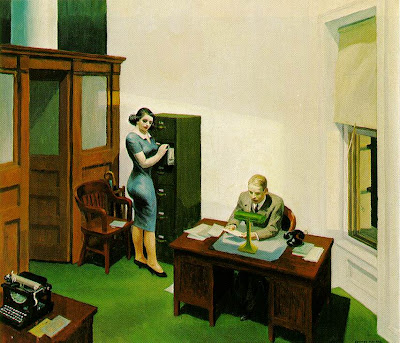Hopper's art work is varied in terms of the locations he works from, whether it be a small room to an open street, but one quality that reoccurs throughout his paintings is the use of perspective. This can be obvious in some paintings but in others not so much using it subtly so as not to detract from the main focus of the painting. This subtle use of perspective is evident in Hopper's painting Night Hawks (1942) not so much in the foreground with the diner but with the shops in the background. They are put into perspective very slightly to create just enough depth to the painting to make it real as though it actually exists somewhere in reality.
 |
| Fig. 1 Night Hawks |
In addition to this Hopper's paintings feel cropped and the scenes within them isolated and framed from what might be going on around them. This effect creates a focus to the image. Hopper works by picking out subjects of interest, in many cases people, and tries to focus in on them and make it seem as though the audience is looking in on a particular moment of their lives. The paintings are to some degree an invasion of privacy, like we, as the onlookers, are intended to spy on the unsuspecting individuals. Again, in Night Hawks, perhaps the figure most central to the painting is intended to be us symbolised in Hopper's mind, as the other individuals a grouped together with this particular character watching them.
This however causes its own effect on the atmosphere and in conjunction with the dark exterior of the buildings and the colour choice, makes it uncomfortable, mysterious and a little bit sinister. The light in the painting focuses on the diner's interior possibly in an attempt to expose the individuals further. However it casts numerous shadows and even distorts the view of the shop fronts behind the window of the diner which adds further mystery to this painting.
Another effect Hopper creates through his art is that the subjects are 'caught in the moment'. The subject/s tend to be caught at a point of vulnerability which in some cases can lead to multiple interpretations. Such is the case with Hopper's Office at Night. Is the female figure listening to the man at the desk or if someone were to notice the paper half hidden behind the desk that she is waiting for him to notice her.
 |
| Fig. 2 Office at Night |
Fig. 1. Hopper, Edward (1942) Night Hawks [oil on canvas]
http://www.sauer-thompson.com/junkforcode/archives/2005/10/post_21.html
(Accessed on 02.12.10)
Fig. 2. Hopper, Edward (1940) Office at Night [oil on canvas]
http://art.wisc.edu/art108/images/default.asp?fldWeekID=29
(Accessed on 02.12.10)
No comments:
Post a Comment